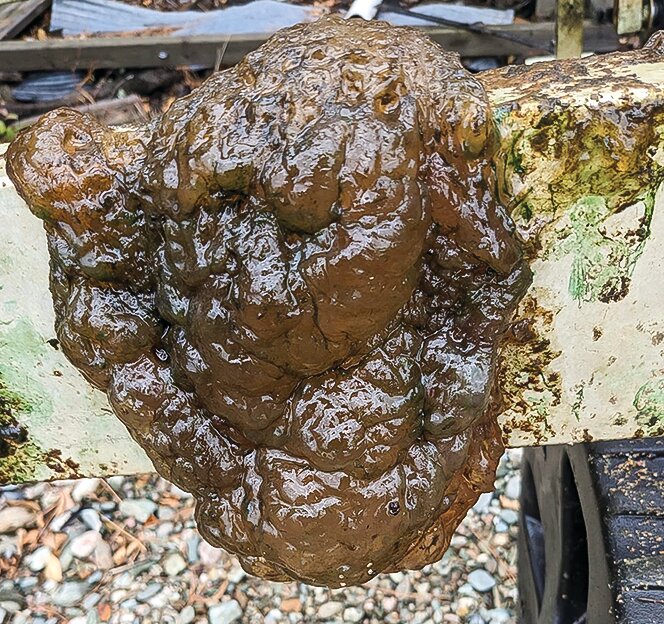Support the Timberjay by making a donation.
Bryozoans bring an other-wordly feel to Minnesota lakes
They may have an ick factor, but they’re a sign of healthy water
FALL LAKE- If the strange blob that Paul Pelkola found on his Fall Lake boat lift had been green instead of brown, it could have been straight out of “The Attack of the Green Slime,” one …
This item is available in full to subscribers.
Attention subscribers
To continue reading, you will need to either log in to your subscriber account, or purchase a new subscription.
If you are a current print subscriber, you can set up a free website account and connect your subscription to it by clicking here.
If you are a digital subscriber with an active, online-only subscription then you already have an account here. Just reset your password if you've not yet logged in to your account on this new site.
Otherwise, click here to view your options for subscribing.
Please log in to continue |
Bryozoans bring an other-wordly feel to Minnesota lakes
They may have an ick factor, but they’re a sign of healthy water
FALL LAKE- If the strange blob that Paul Pelkola found on his Fall Lake boat lift had been green instead of brown, it could have been straight out of “The Attack of the Green Slime,” one of the most famous bad science fiction films ever made.
Yet what Pelkola found on his boat lift was not an alien from outer space, but rather a colony of simple invertebrate aquatic animals known as bryozoans of the species Pectinatella magnifica.
While they may look other-worldly, bryozoans of this species are a ubiquitous resident of Minnesota’s freshwater lakes and rivers, where they frequently form slimy-looking colonies in shallow waters, growing on submerged logs or branches and the underwater portions of docks, boathouses, moorings, boat bottoms, and other man-made structures in the water. Byrozoan colonies can also float freely, though this is less common.
Pelkola recently posted his picture of his bryozoan colony on the “What’s Up, Ely?” Facebook group, wondering what his slime could be. The identity of the gooey-looking lifeform was quickly revealed, along with one commenter posting, “I will not ever swim again!”
The life of a blob
One bryozoan is called a zooid (pronounced “ZOH-id”). These tiny animals get together in the warm part of the year to form complex colonies that resemble coral, however, each zooid lives inside a gelatinous tube that’s made of mostly protein instead of the hard calcium carbonate exoskeleton of coral. It’s the protein exoskeleton that gives a colony of Pectinatella magnifica its icky slimy appearance.
Bryozoans feed by filtering tiny algae and protozoa through a crown of tentacles. In turn, they are eaten by snails, caddisflies, midges, and small fish. They are a competitor for living space with the invasive species of zebra mussels that plague North American freshwater lakes. So don’t be tempted to clean that bryozoan colony from the undersides of your dock because they help combat the spread of the undesirable zebra mussel.
Colonies of Pectinatella magnifica start with just a few zooids and then grow during the summer, forming yellow-brown gelatinous blobs that can be as large as a basketball.
According to the Minnesota Department of Natural Resources, bryozoan colonies will release microscopic larval “stratoblasts” before they disintegrate with the onset of colder weather. The stratoblasts can survive winter conditions and will create new zooids come spring, starting the colony-building cycle for the upcoming year.
While the ick factor of a bryozoan colony in Minnesota waters can be substantial, the individual zooids seen through a microscope are actually quite beautiful.
Healthy water
Bryozoans can make water cleaner by decreasing turbidity. According to the U.S. Fish and Wildlife Service (USFWS), as filter-feeders, bryozoans also take in clay and silt along with their diet of algae and diatoms, so the clarity of the water where they live will actually improve. A single tiny zooid can filter as much as eight milliliters (one-quarter ounce) of water every day; and there are hundreds, even thousands, in a single colony.
“In general, because they are filter feeders, bryozoans want high-quality water,” DNR biologist Don Eaton told the Timberjay. He cautioned that was the general case, especially for bryozoans in the ocean.
Narrowing in on bryozoans in freshwater lakes, both the USFWS and the U.S. Army Corps of Engineers both identify Pectinatella magnifica as an indicator of a healthy lake, though the “Field Guide to Fresh Water Invertebrates of North America (Elsevier, 2001)” notes that freshwater bryozoans can tolerate acidic water conditions and eutrophication.
Bryozoans in freshwater are harmless and non-toxic for humans. They can create a nuisance when they occasionally clog water intakes. Bryozoan colonies can be safely detached from surfaces if necessary and set afloat to find a new home without harming most of the organisms living in the colony.






